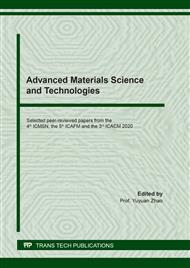[1]
DAWES, C. J., Friction Stir Joining of Aluminium Alloys, Bulletin. 6 (1995). http://ci.nii.ac.jp/naid/10006401749/en/ (accessed February 13, 2020).
Google Scholar
[2]
W.M. Thomas, E.D. Nicholas, J.C. Needham, M.G. Murch, P. Templesmith, C.J. Dawes, Friction Stir Welding, PCT/GB92/02203-No. 9125978.8., (1991).
Google Scholar
[3]
Z.G. El Chlouk, G. Ayoub, G.T. Kridli, R.F. Hamade, Intermetallic compound formation in Al/Mg friction stir welded (FSW) butt joints, in: ASME Int. Mech. Eng. Congr. Expo. Proc., 2014. https://doi.org/10.1115/IMECE2014-37213.
DOI: 10.1115/imece2014-37213
Google Scholar
[4]
V.C. Shunmugasamy, B. Mansoor, G. Ayoub, R. Hamade, Friction Stir Welding of Low-Carbon AISI 1006 Steel: Room and High-Temperature Mechanical Properties, J. Mater. Eng. Perform. 27 (2018) 1673–1684. https://doi.org/10.1007/s11665-018-3280-3.
DOI: 10.1007/s11665-018-3280-3
Google Scholar
[5]
X. Liu, S. Lan, J. Ni, Analysis of process parameters effects on friction stir welding of dissimilar aluminum alloy to advanced high strength steel, Mater. Des. 59 (2014) 50–62. https://doi.org/10.1016/j.matdes.2014.02.003.
DOI: 10.1016/j.matdes.2014.02.003
Google Scholar
[6]
H. Uzun, C. Dalle Donne, A. Argagnotto, T. Ghidini, C. Gambaro, Friction stir welding of dissimilar Al 6013-T4 To X5CrNi18-10 stainless steel, Mater. Des. 26 (2005) 41–46. https://doi.org/10.1016/j.matdes.2004.04.002.
DOI: 10.1016/j.matdes.2004.04.002
Google Scholar
[7]
M.M. Atabaki, M. Nikodinovski, P. Chenier, R. Kovacevic, UNCLASSIFIED: Distribution Statement A. Approved for public release Welding of aluminum alloys to steels: an overview, (n.d.).
DOI: 10.1515/jmsp-2014-0007
Google Scholar
[8]
T. Tanaka, T. Morishige, T. Hirata, Comprehensive analysis of joint strength for dissimilar friction stir welds of mild steel to aluminum alloys, Scr. Mater. 61 (2009) 756–759. https://doi.org/10.1016/j.scriptamat.2009.06.022.
DOI: 10.1016/j.scriptamat.2009.06.022
Google Scholar
[9]
C.M. Chen, R. Kovacevic, Joining of Al 6061 alloy to AISI 1018 steel by combined effects of fusion and solid state welding, Int. J. Mach. Tools Manuf. 44 (2004) 1205–1214. https://doi.org/10.1016/j.ijmachtools.2004.03.011.
DOI: 10.1016/j.ijmachtools.2004.03.011
Google Scholar
[10]
K. Kimapong, T. Watanabe, Friction stir welding of aluminum alloy to steel, Weld. J. (Miami, Fla). 83 (2004) 277–282.
Google Scholar
[11]
W. Liu, J. Ma, M. Mazar Atabaki, R. Kovacevic, Joining of advanced high-strength steel to AA 6061 alloy by using Fe/Al structural transition joint, Mater. Des. 68 (2015) 146–157. https://doi.org/10.1016/j.matdes.2014.12.028.
DOI: 10.1016/j.matdes.2014.12.028
Google Scholar
[12]
S. Rajakumar, C. Muralidharan, V. Balasubramanian, Influence of friction stir welding process and tool parameters on strength properties of AA7075-T6 aluminium alloy joints, Mater. Des. 32 (2011) 535–549. https://doi.org/10.1016/j.matdes.2010.08.025.
DOI: 10.1016/j.matdes.2010.08.025
Google Scholar
[13]
Z.G. El Chlouk, H.H. Achdjian, G. Ayoub, G.T. Kridli, R.F. Hamade, The effect of tool geometry on material mixing during friction stir welding (FSW) of magnesium AZ31B welds, in: Proc. TMS Middle East - Mediterr. Mater. Congr. Energy Infrastruct. Syst. MEMA 2015, (2015).
DOI: 10.1002/9781119090427.ch23
Google Scholar
[14]
C. Blignault, D.G. Hattingh, M.N. James, Optimizing Friction Stir welding via statistical design of tool geometry and process parameters, J. Mater. Eng. Perform. 21 (2012) 927–935. https://doi.org/10.1007/s11665-011-9984-2.
DOI: 10.1007/s11665-011-9984-2
Google Scholar
[15]
P. Motalleb-nejad, T. Saeid, A. Heidarzadeh, K. Darzi, M. Ashjari, Effect of tool pin profile on microstructure and mechanical properties of friction stir welded AZ31B magnesium alloy, Mater. Des. 59 (2014) 221–226. https://doi.org/10.1016/j.matdes.2014.02.068.
DOI: 10.1016/j.matdes.2014.02.068
Google Scholar
[16]
L. Long, G. Chen, S. Zhang, T. Liu, Q. Shi, Finite-element analysis of the tool tilt angle effect on the formation of friction stir welds, J. Manuf. Process. 30 (2017) 562–569. https://doi.org/10.1016/j.jmapro.2017.10.023.
DOI: 10.1016/j.jmapro.2017.10.023
Google Scholar
[17]
Efunda, Efunda: The ultimate online reference for engineers, (n.d.). www.efunda.com.
Google Scholar


